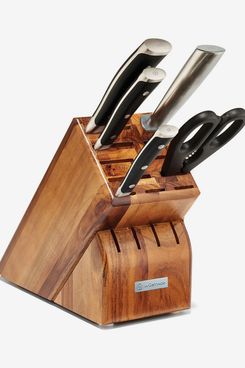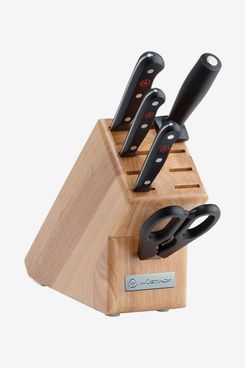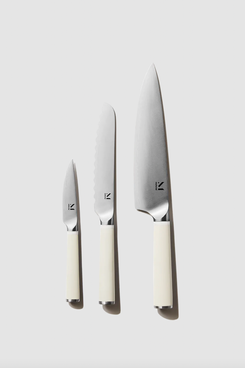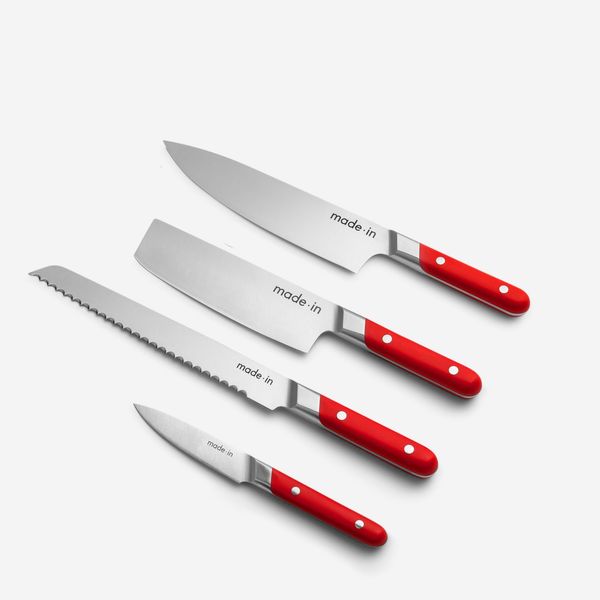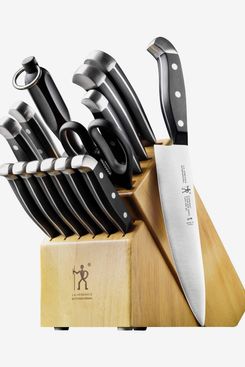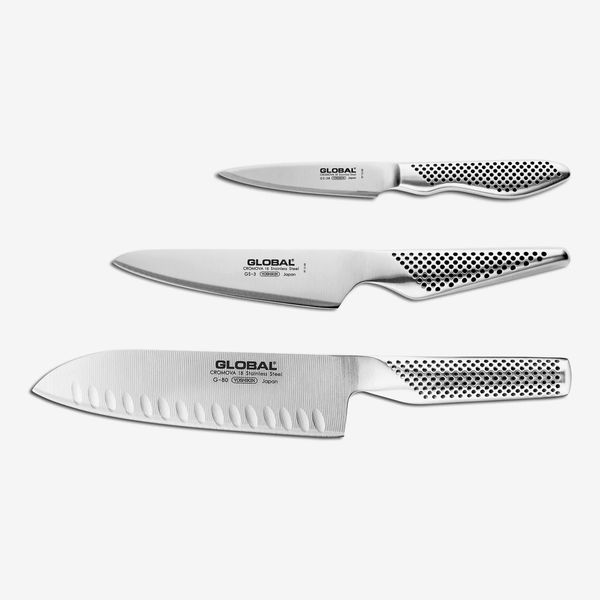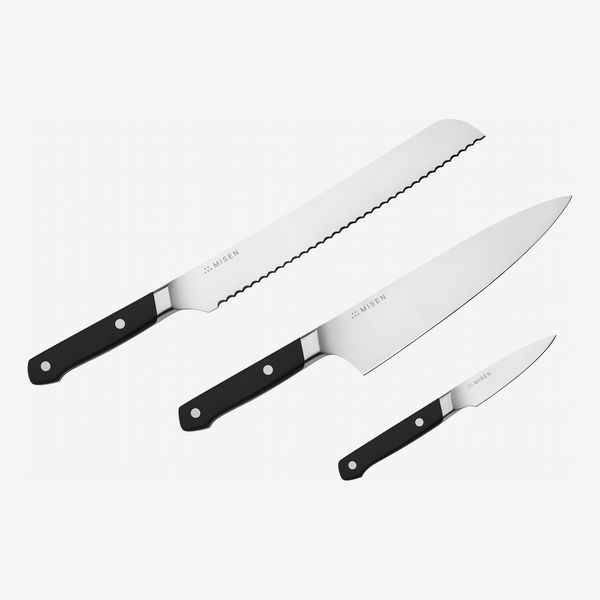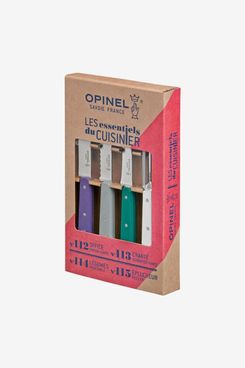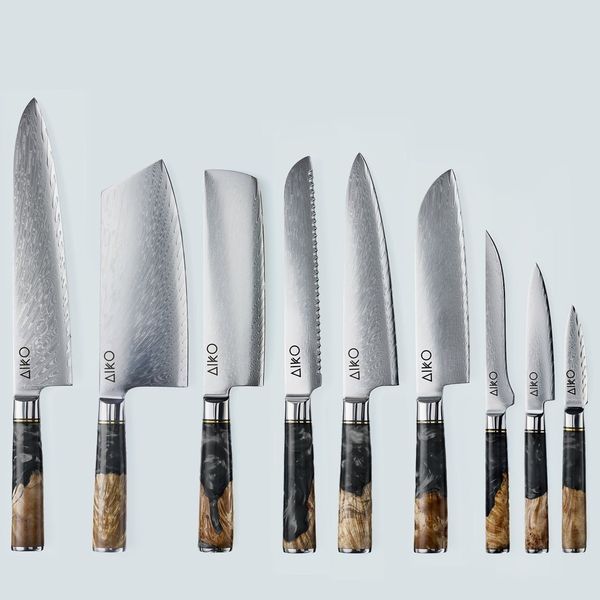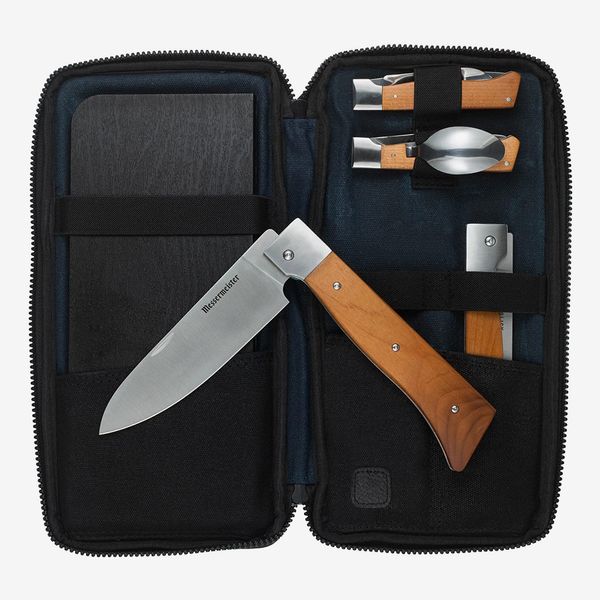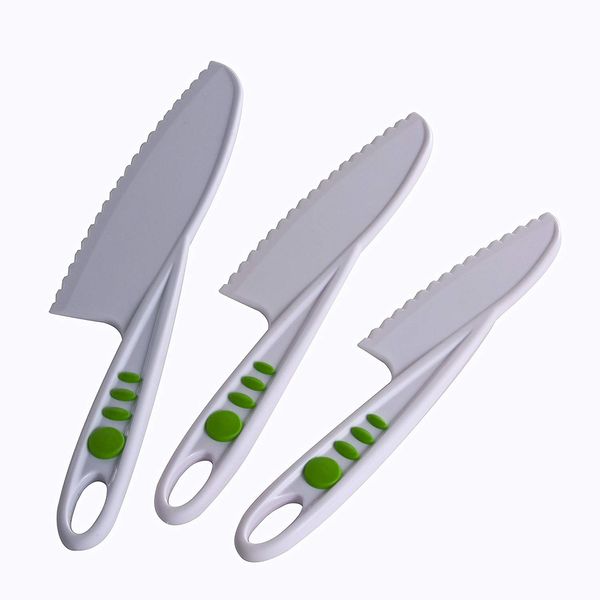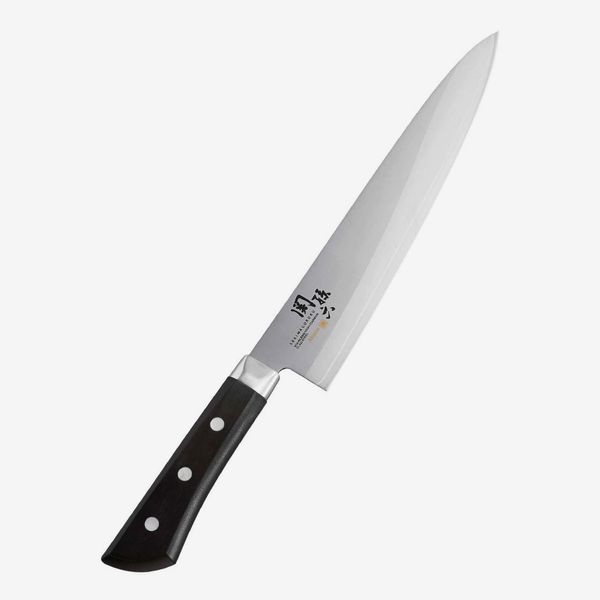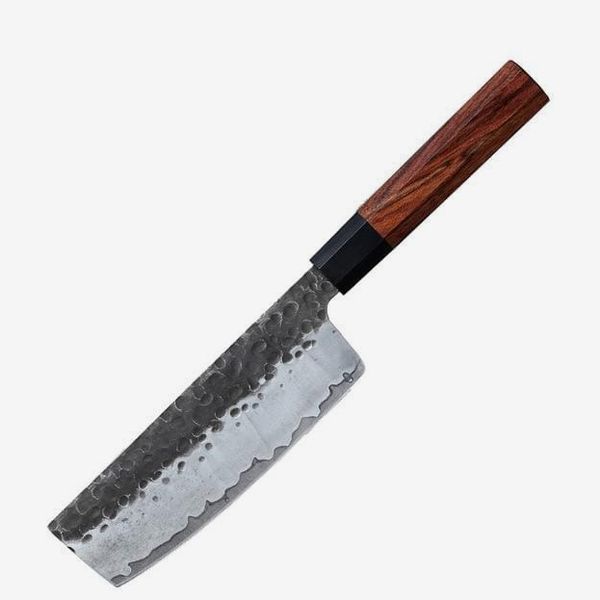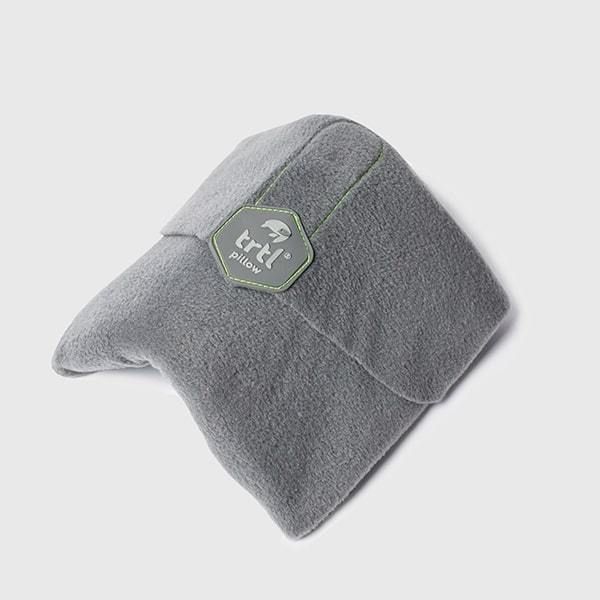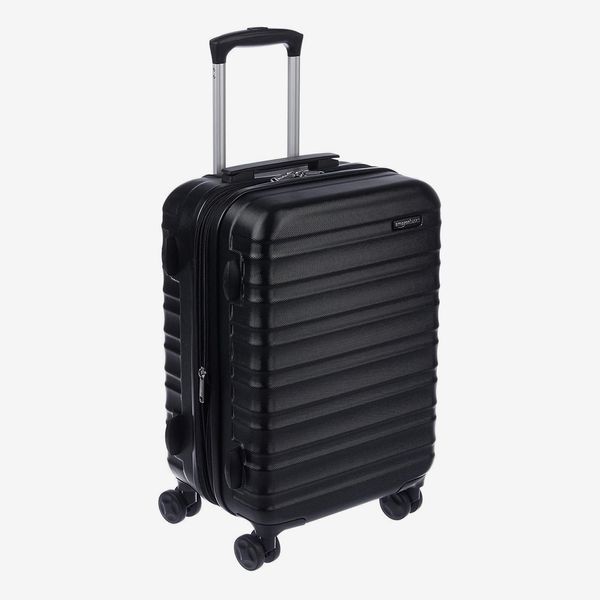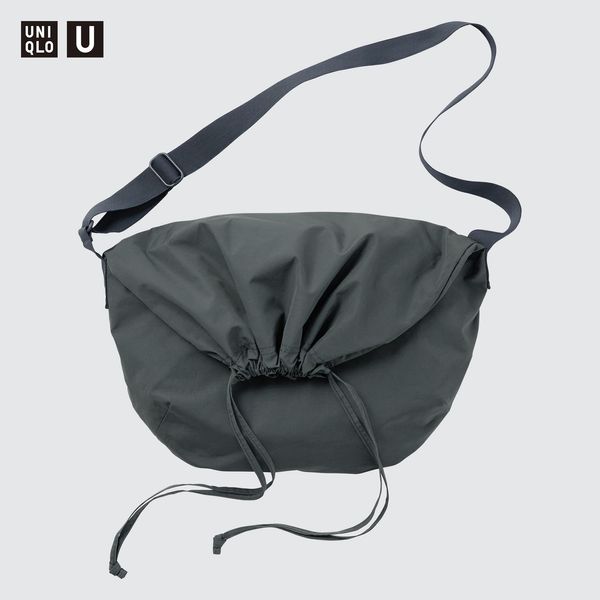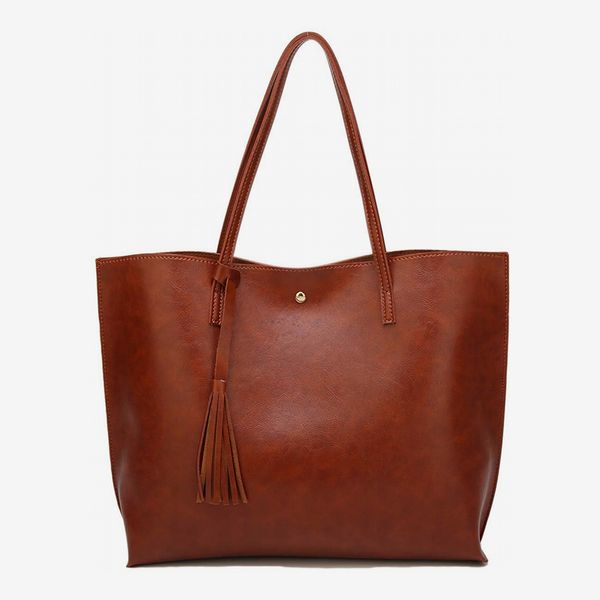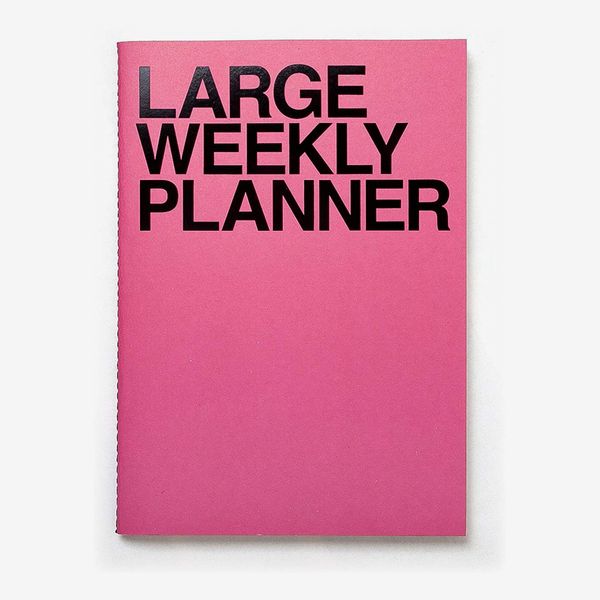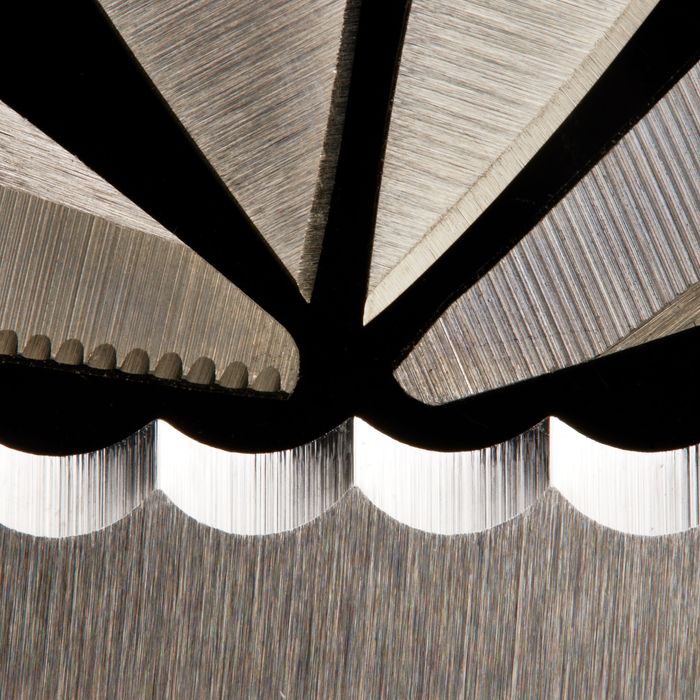
In this article
I’ve browsed the knife-set offerings at many home-goods stores over the years — though they’re initially appealing, upon closer inspection, I inevitably notice some pieces in strange sizes or with unappealing curves that I know will go to die in my cutlery drawer.
Buying prepackaged multiples of cookware and tools of any kind can be tricky, but the key is assessing what you really need, whether you’re starting completely from scratch, redoing the basic makeup of your collection, or simply want to add a handful of additional blades to what you already own. To find the very best compositions, I talked to nearly a dozen experts and tested several groupings myself and ended up with a varied list: three pieces all the way up to 20-something, all chef’s knives or mixed kinds, ones that include sharpening tools and blocks (and ones that don’t). Read on to find the assortment that best suits your own kitchen.
What we’re looking for
Number of pieces
Knife sets can come with anywhere from three pieces to more than 20. For this story, I (and the experts I spoke to) leaned significantly towards the smaller end of that spectrum. I’m of the opinion that most of the time, it makes sense to buy a smaller core group — a chef’s knife, a paring knife, and a serrated knife — and then assess. Are you always wishing you had a second chef’s knife so you don’t have to clean in between tasks? Does it turn out you’d benefit from a boning knife because you eat fish and chicken multiple days a week? From your core group, you can always add individual implements as you see what your real needs are.
European- or Japanese-style
This classification is a bit of a tricky one because not every knife falls distinctly into one category or the other (and some knives don’t fall into either at all). And yet these terms are still commonly used, the distinctions notable enough that it’s good to have a sense of the main characteristics of each — especially when it comes to the chef’s knife in each of these sets. First of all, European-style is kind of a catch-all term that can also be called German-style, French-style, and Western-style. These are generally heavier with a thicker, more curved blade to facilitate rocking back and forth with the tip down on your cutting board. On the other hand, Japanese-style tend to be lighter with a thinner blade and straighter edge to facilitate extreme precision. To make things even more confusing, some Japanese companies make some European-style knives, and some European and American companies make Japanese-style knives. But here I’ve denoted the style of each to the best of my ability, and then gone into more detail in the descriptions.
Best overall knife set
Number of pieces: Six | Style: European
Wüsthof is a classic company. It’s the one that cook and Top Chef Canada host Eden Grinshpan was told to buy when she was in culinary school, the one cookbook author Erin Gleeson registered for when she got married a decade ago and still uses, and the one preferred by multiple celebrity chefs with varying cooking styles (a quick Google search will tell you that both Ina Garten and Gordon Ramsay swear by them). “They’re just superhigh quality, and they really stand the test of time,” Grinshpan says. “I still have some of the pieces in my kitchen.” This particular set comes with a paring knife, a chef’s knife, and a serrated knife — the only three you really need when it comes down to performing most cooking tasks, as I explained before. It also includes some helpful (not superfluous) accessories: a wooden block to hold your blades safely, a honing steel to sharpen the edges, and a pair of “come-apart” kitchen shears (the “come-apart” makes them easy to clean). “I use the scissors all the time,” Gleeson says, “for cutting everything from pizza and flatbreads to scallions.”
Best less expensive knife set
Number of pieces: Six | Style: European
This more affordable set from Wüsthof has a similar setup. The paring knife is a half-inch smaller (which shouldn’t make any noticeable difference), the serrated knife is three inches smaller (a utility knife intended to cut things like tomatoes as opposed to crusty bread), and the block is made from a different variety of wood (beechwood instead of acacia). Most notably, the knives are stamped (cut from one large sheet of steel) instead of forged (made from a single bar of steel that is heated and then pounded into shape by hand or machine). This makes them not quite as durable but much cheaper — and they can totally do the trick (and do it well), especially if you aren’t particularly hard on your knives.
Best simple knife set
Number of pieces: Three | Style: Japanese
Strategist-favorite brand Material Kitchen sells a knife set with the three most basic, essential knives. The eight-inch chef’s knife is a favorite of recipe developer and writer Rebecca Firkser, who says it’s balanced in her hand and has stayed in great shape for over three years when sharpened every couple of months at home. “I got it in the neutral color, which is just plain pleasing to me in a sea of black-handled knives,” she says. Notably, the serrated knife is six inches long, which is significantly shorter than most. While it wouldn’t be substantial enough to cut through a round cake layer to even out the surface, it can handle other tasks well, like slicing bread and tomato slices. I, for one, even prefer shorter blades since they give you more control. And finally, there’s a 3.5-inch paring knife for intricate tasks.
Best four-piece knife set
Number of pieces: Four | Style: European
Made In makes a relatively uncommon combination of knives — the three essentials, plus a Nakiri knife, which I have found to be a useful addition. It looks a bit like a small cleaver but is meant for cutting vegetables with an entirely straight edge. The blade is only six inches long (two inches shorter than another Nakiri I own that I find too big for nuanced tasks like chopping through cauliflower). This one gives great control and is still hardy enough to hack away at a squash. I also really like the chef’s knife, which is on the heavier side (eight ounces) without feeling burdensome. The weight feels good in my hand and helps guide the sharp edge seamlessly through whatever I’m cutting.
Culinary producer Kiano Moju first bought this set when she was stocking her culinary creative studio, a kitchen she needed to outfit from scratch. “They hold really nicely,” she says. “When I was working at Sur La Table years ago, someone taught me how to cut with your thumb on the top of the spine, and it balances nicely if that’s how you use your knives. They’re well balanced, and not too heavy at all. Plus, they’re really cute. They come in red, which is my favorite.”
Best knife set with steak knives included
Number of pieces: 15 | Style: European
J.A. Henckels is the more affordable sister brand to Strategist-favorite Zwilling, and this set was a top pick from a previous version of this story. We can understand why it’s so popular among readers — it boasts 4.7 out of five stars on Amazon, with nearly 13,000 ratings. “The knives, while stamped not forged, still have decent heft,” one reviewer notes. “And the handles, though polymer, don’t feel like low-quality plastic.” Beyond quality, there’s an additional feature — one that isn’t usually a part of kitchen-knife sets — that makes this particular buy stand out: It includes six matching serrated steak knives that, according to one reviewer, “don’t rip or shred meat.”
Best knife set without a serrated knife
Number of pieces: Three | Style: Japanese with some European influence
Every other set on this list includes a serrated knife, but if you’re looking to expand your collection without that particular blade, this Global collection fits the bill. (I once found myself in that exact predicament: I already own a serrated blade that I love and find to be plenty for the relatively infrequent tasks it is made for, but wanted a few other straight-edged blades for the high volume of cooking that goes on in my kitchen.) With this configuration, I got a 7-inch chef’s knife (notably, our best overall chef’s knife), a 5-inch utility knife, and a 3.5-inch paring knife. They all hold an ultrasharp edge, are lightweight enough to maneuver with ease but heavy enough to feel in control, and have a comfortable grip. In particular, I reach for the utility knife more than expected. Its size is right between the other two with more of an angled blade. This combination makes it useful for tasks that aren’t so delicate but still require some precision, like cutting into a head of broccoli.
Best knife set without a paring knife
Number of pieces: Three | Style: Japanese with some European influence
This Hedley & Bennett trio comes with a long and lean serrated knife and, as with the Global set, a utility knife. The third piece is a chef’s knife recommended by chef Melissa King and Zoya Roya, founder of Fysh Foods, both of whom describe it as “well balanced,” with Roya adding that it’s “not too heavy to handle but heavy enough that it still glides through whatever you’re cutting with ease.”
Like Roya, I find the most striking feature of all three to be the weight. The serrated knife feels so light for the size. While I have another artisan Japanese serrated knife in my collection that’s a bit shorter and heavier, this one has become my go-to for slicing through big loaves of bread. The utility knife, which is a bit longer than the Global with a straighter edge, feels nimble in my hand. I use it to trim the fat off meat and even slice off fish skin (I don’t own a boning knife). The look of the knives is sleek, too. They come in green, white, and black, each with brass rivets.
Best less expensive knife set without a paring knife
Number of pieces: Three | Style: Japanese and European
For another set with a chef’s knife, serrated knife, and utility knife, consider Misen. “I really like these knives as value buys,” says Jeff Strauss, owner and chef of Jeff’s Table and Oy Bar in Los Angeles. “One of the things knife nerds talk about is steel hardness, and these are on the harder end of bendy, which is a sweet spot.” As he explains it, they’re hard enough to sharpen easily and they hold an edge very well. But they’re not so hard that they move in a funky way that can take some getting used to. You can feel the difference with a super hard blade, and even sometimes break it if you make the wrong movements. “I know a bunch of pro chefs who use these,” he says. “I have six of them. You don’t have to be too, too precious.”
When Strategist editor Maxine Builder tested a bunch of DTC cookware, including Misen’s knives, she also found that the edges stayed sharp even after a few months of use and that for a price comparable to one of those “big knife-block sets you can get at Target or Amazon,” they’re a “significant upgrade.”
Best paring knife set
Number of pieces: Four | Style: European
Andrew Brady, chef and partner at the Boston-area restaurants Dear Annie and Field and Vine, has several sets of these knives in his work kitchens at all times because they’re so versatile. The collection comes with a classic paring knife, two serrated paring knives (with more pronounced and subtler teeth), and a bonus vegetable peeler. “Smaller knives tend to be made more cheaply,” he says, “but these are sharp.” He calls the dramatically ridged model a “serious workhorse” that’s great for peppers and chilis, garlic, and shallots, or “small foods that still benefit some serious serrated power,” he says. The subtler ridged one, which he uses for more delicate tasks like cutting through tarts and cherry tomatoes, also comes with a hook-like shape at the tip of the knife. That feature is “useful for handheld tasks where you need to get into a piece of food, like cutting the button off a Brussels sprout or the stem off a strawberry,” he says.
Best high-level knife set
Number of pieces: Up to nine | Style: Japanese and European
If you really want to go all out, this set is a real beauty. The design, as you can plainly see, is eye-catching from the blade down to the handle. The pieces also work incredibly well, with ultra-sharp edges and a comfortable grip. For many months now, I’ve regularly used several of them and haven’t had a need to do any upkeep as of yet. I’m a particular fan of the nakiri knife (seriously, I’ve never had as much ease cutting vegetables) and the boning knife (specific, yes, but comes in so handy when I’m cooking meat and fish).
You can choose anywhere from three to nine pieces, and while this is a Japanese brand and some pieces are designed as such (like the santoku knife), there are others with European-style influence (like the chef’s knives, which have that more curved shape).
Best knife set for camping
Number of pieces: Six | Style: European
This recommendation from recipe developer and cookbook author Louisa Shafia isn’t strictly a knife set with only knives included, but it comes from the knife company Messermeister, which she has been using since she went to culinary school a couple of decades ago. It’s a compact camping set with two particularly good knives — a foldable six-inch chef’s knife and a foldable six-inch fillet knife (yes, those are full-size, made from the same steel as their regular ones). “It’s everything you would need to go camping and make really nice food,” Shafia says. “You can even handle things if you catch a fish. Plus you need something to cut against that’s not gonna ruin the knives, so it’s nice that it comes with a cutting board.”
Some more knives we’ve written about
Our experts
• Andrew Brady, chef and partner at Dear Annie and Field and Vine
• Maxine Builder, Strategist editor
• Rebecca Firkser, recipe developer and writer
• Erin Gleeson, cookbook author
• Eden Grinshpan, cook and Top Chef Canada host
• Melissa King, chef
• Kiano Moju, culinary producer
• Zoya Roya, founder of Fysh Foods
• Louisa Shafia, recipe developer
• Jessie Sheehan, recipe developer
• Jeff Strauss, owner and chef of Jeff’s Table and Oy Bar
The Strategist is designed to surface the most useful, expert recommendations for things to buy across the vast e-commerce landscape. Some of our latest conquests include the best women’s jeans, rolling luggage, pillows for side sleepers, ultra-flattering pants, and bath towels. We update links when possible, but note that deals can expire and all prices are subject to change.
Every editorial product is independently selected. If you buy something through our links, New York may earn an affiliate commission.

